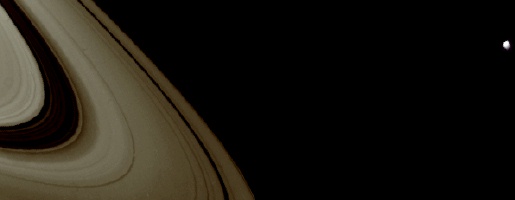 |
||
|
Voyager
image of Enceladus and Saturn's rings.
|
||
| ENCELADUS - MOON OF SATURN | ||
| Enceladus was a giant, with a hundred arms, who sprang from the Earth (Gaia) when the blood of Uranus fell upon it. In a struggle against the Olympians he was hit by a bolt of lightning from Zeus and buried under Mount Aetna. Features on Enceladus are named after characters from Sir Richard Burton's translation of "The Arabian Nights". Enceladus was discovered in 1789 by Sir William Herschel, the discoverer of Uranus. | ||
| Orbit | ||
| Enceladus orbits Saturn at a distance of 238,020 kilometres. The orbit is nearly a perfect circle, with an eccentricity of only 0.0045, and inclined only 0.02o to Saturn's equatorial plane. Enceladus has an orbital period of 1.37 days. | ||
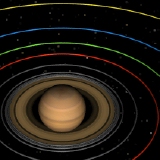 The orbits of Enceladus, Tethys, Telesto, Calypso, Dione, Helene, and Rhea. |
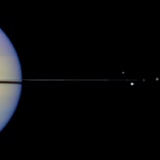 Hubble Space Telescope image of Mimas, Tethys, Janus and Enceladus, clustered at the western side of the edge-on ring system. |
|
| Physical properties | ||
| Enceladus is the second innermost of Saturn's larger moons. It has a diameter of 498 kilometres and is amongst the smallest of the spherical moons. It is half the size of the next largest satellite, Tethys. | ||
| Interior | ||
| Enceladus has a density of 1120 kg m-3 , close to that of water. This implies that Enceladus consists of water ice, with a small amount of heavier rock. Although little is known of its interior, it is unlikely to be molten, due to the moon's small size and rapid heat loss. | ||
| Magnetic field | ||
| No magnetic field has been detected. | ||
| Atmosphere | ||
| No atmosphere has been detected. | ||
| Surface | ||
| Voyager 2 returned the best pictures - its closest approach took it about 87,140 kilometres from Enceladus, but it was only able to obtain images of about half of the surface. The earlier Voyager 1 also made a flyby of Enceladus but at a much greater distance. | ||
| Of Saturn's moons, Enceladus has some of the most varied terrain. It is also one of the most reflective objects in the Solar System. It has an albedo approaching 1.0, which means that it reflects nearly all the light which reaches its surface. This is because it is coated with clean ice. The highly reflective surface means that it is very cold. | ||
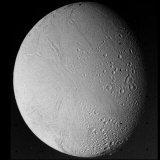 Enceladus is one of the brightest moons in the Solar System. |
||
| At first glance Enceladus looks a lot like Ganymede. It has heavily cratered terrain which is cross-cut by wide grooved bands. A closer look at the surface reveals six main terrain types. It appears that Enceladus has had a long history of geological change, and that the surface has been renewed at intervals. | ||
 Enceladus exhibits a variety of terrains - shown here are craters and grooves. |
||
| There are three cratered terrains. The most heavily cratered regions have lots of craters in the 10 to 20 kilometre size range but they are heavily degraded. The biggest craters are about 35 kilometres across. A second type of cratered landscape has craters in the same size range and a similar density of craters but they have sharper rims. As these are better preserved, they are thought to be younger. The third kind of cratered surface is called cratered plains. Cratered plains have fewer craters which tend to be smaller, mostly about 5 to 10 kilometres. | ||
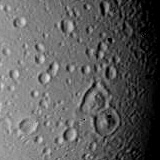 Enceladus' craters imaged by Voyager 2 - the largest are Ali Baba and Aladdin. |
||
| As well as cratered landscapes, there are two types of plains; both of these are smoother than the cratered regions. The older plains have a few craters, whereas the younger plains have none at all. The plains were probably built up by the eruption of ices in episodes of widespread volcanic flooding. | ||
| Interpreted as the youngest terrain are the ridged and grooved plains. They are dominated by long and sinuous grooves and cut through the older cratered landscapes. The smooth linear ridges are thought to result from some form of ice-volcanism. Eruptions are thought to have occurred when the crust expanded and fractured, allowing a mixture of water, with methane and other hydrocarbons to reach the surface. Water alone would not be able to erupt at the low temperatures found on Enceladus, so it was probably contaminated with other compounds. This may have been the case on other bodies, like Ariel, which also would be too cold to have erupted liquid water. | ||
| The heat required to drive volcanism on Enceladus is not likely to have been retained from the formation of the moon and residual heat from early impacts, or even from the decay of radioactive elements. Enceladus is too small. It should have lost its heat several thousand million years ago and ceased to evolve. Instead, Enceladus has many fresh looking surfaces. Signs of more recent geological activity show that Enceladus must have possessed a molten interior lately. | ||
| Though it is not the case at the moment, it is likely that in relatively recent history (a few million years ago) Enceladus was locked in a resonant orbit with Saturn and another moon, probably Dione. This means that their orbits could line up periodically. When they were in a line, Enceladus in the middle would have been stretched into an egg shape between Saturn and Dione. These are the forces that apply to Jupiter's moon Io when it is sandwiched between Europa and Jupiter. | ||
| When the configuration changes, the stresses are relaxed, until the next alignment. A 2:1 resonant orbit with Dione would have squeezed Enceladus like a rubber ball, heating it up as if bending a piece of metal back and forth. Tidal forces, when they work on a solid planet in this way, create what is known as a "body tide". | ||
| There is some evidence that Enceladus is active today. Located in Saturn's E ring, it is possible that eruptions on Enceladus supply it with material. Researchers say that because the tiny particles which make up the ring would not last for very long (a few thousand years), the ring must be replenished and that dust ejected by volcanoes or geysers on Enceladus is the most likely source of material. | ||
 Voyager image of Enceladus and Saturn's rings. |
||
| In addition, Enceladus has a very bright surface. This suggests that it consists of purer ices of methane and water, uncontaminated by rock dust like Jupiter's moon Ganymede which is mantled by dark grey rock debris. Since so much of the surface is bright (the older cratered plains as well as the more recently formed ridged plains) it may be that volcanoes are coating the planet with an icy spray or frost. | ||
| There are also patches of smooth material which have been interpreted as recent eruptions of liquids. This further suggests that Enceladus may be active today, and that the interior is still liquid. | ||
| Tectonics | ||
| In the plains of Enceladus are lots of straight grooves. The longest are 50 to 100 kilometres in length. Enceladus is very small, so ice exists in a normal state and not the more compact forms which can exist at the higher pressures encountered within larger bodies. Normal ice expands when it cools. This is what happened when Enceladus' internal heat was depleted, forming the fissures on the surface. | ||
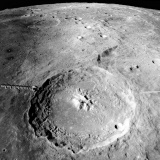 Enceladus has grooves similar to Europa. Shown here is Samarkand Sulci. |
||
| The formation of the bands of ridge and groove terrain is partly tectonic (earth-movement), partly volcanic. Though the surface cooled and expanded, and formed cracks in the older plains, enough internal heat was available to soften the ice allowing it to erupt along fissures forming the ribbed surface. | ||
|
|
||